HRMT20028: A Comprehensive Literature Review on Change Management
VerifiedAdded on 2023/06/08
|11
|2652
|468
Literature Review
AI Summary
This literature review provides a comprehensive overview of organizational change management, examining the internal and external factors that drive change, the roles of senior and line managers in facilitating change, common causes of resistance to change, steps organizations should implement for effective change, and strategies for fostering a change-capable culture. The review incorporates insights from various authors and academic papers, highlighting both the positive and negative aspects of different approaches. Key themes include the importance of communication, employee involvement, and addressing job security concerns to successfully implement organizational changes. The review also discusses the Lewin Change Model as a strategy for ensuring a change-capable culture, while acknowledging its limitations. This assignment is available on Desklib, a platform offering a wealth of study resources, including past papers and solved assignments, designed to support students in their academic endeavors.

Running Head: Organization Change Management
Organizational Change Management
Organizational Change Management
Paraphrase This Document
Need a fresh take? Get an instant paraphrase of this document with our AI Paraphraser
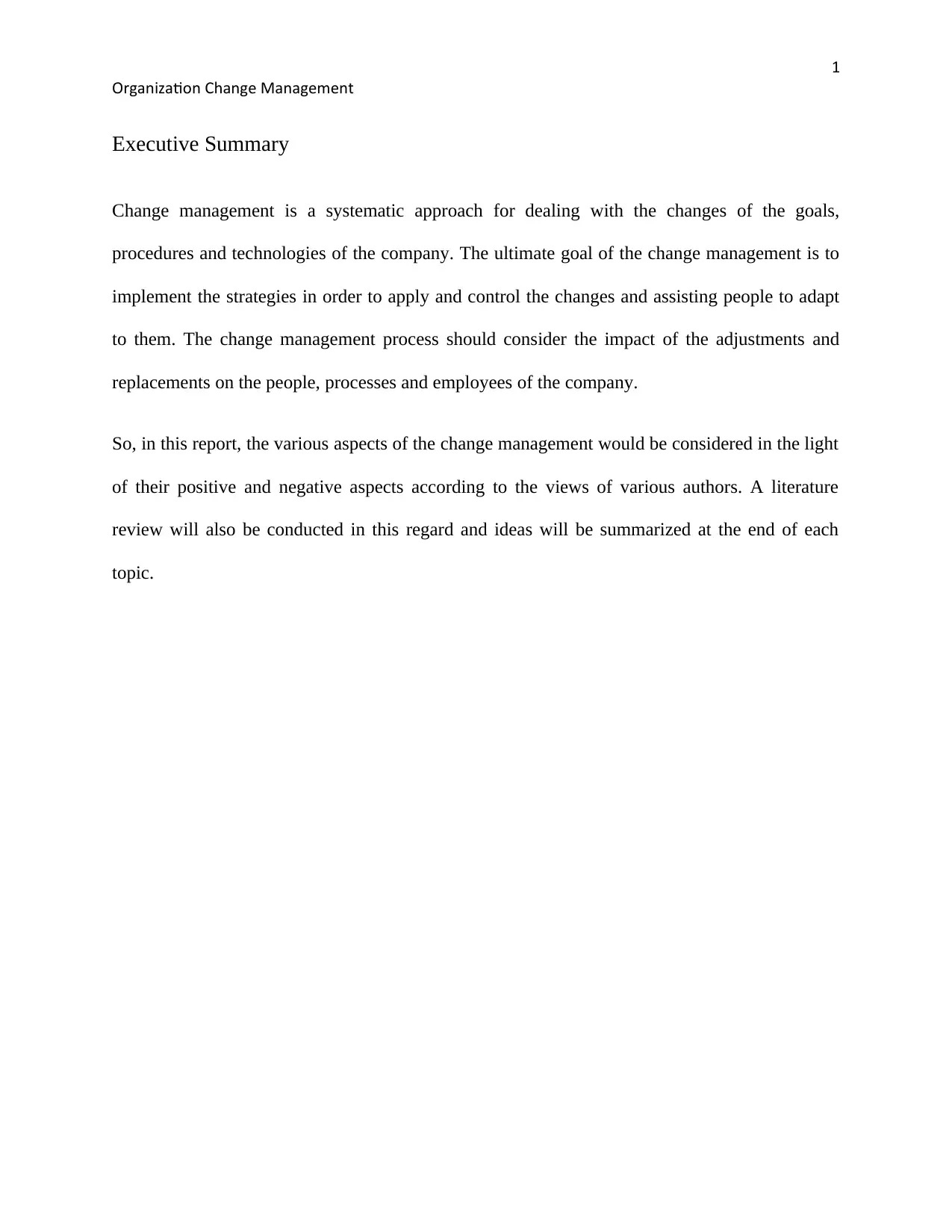
1
Organization Change Management
Executive Summary
Change management is a systematic approach for dealing with the changes of the goals,
procedures and technologies of the company. The ultimate goal of the change management is to
implement the strategies in order to apply and control the changes and assisting people to adapt
to them. The change management process should consider the impact of the adjustments and
replacements on the people, processes and employees of the company.
So, in this report, the various aspects of the change management would be considered in the light
of their positive and negative aspects according to the views of various authors. A literature
review will also be conducted in this regard and ideas will be summarized at the end of each
topic.
Organization Change Management
Executive Summary
Change management is a systematic approach for dealing with the changes of the goals,
procedures and technologies of the company. The ultimate goal of the change management is to
implement the strategies in order to apply and control the changes and assisting people to adapt
to them. The change management process should consider the impact of the adjustments and
replacements on the people, processes and employees of the company.
So, in this report, the various aspects of the change management would be considered in the light
of their positive and negative aspects according to the views of various authors. A literature
review will also be conducted in this regard and ideas will be summarized at the end of each
topic.
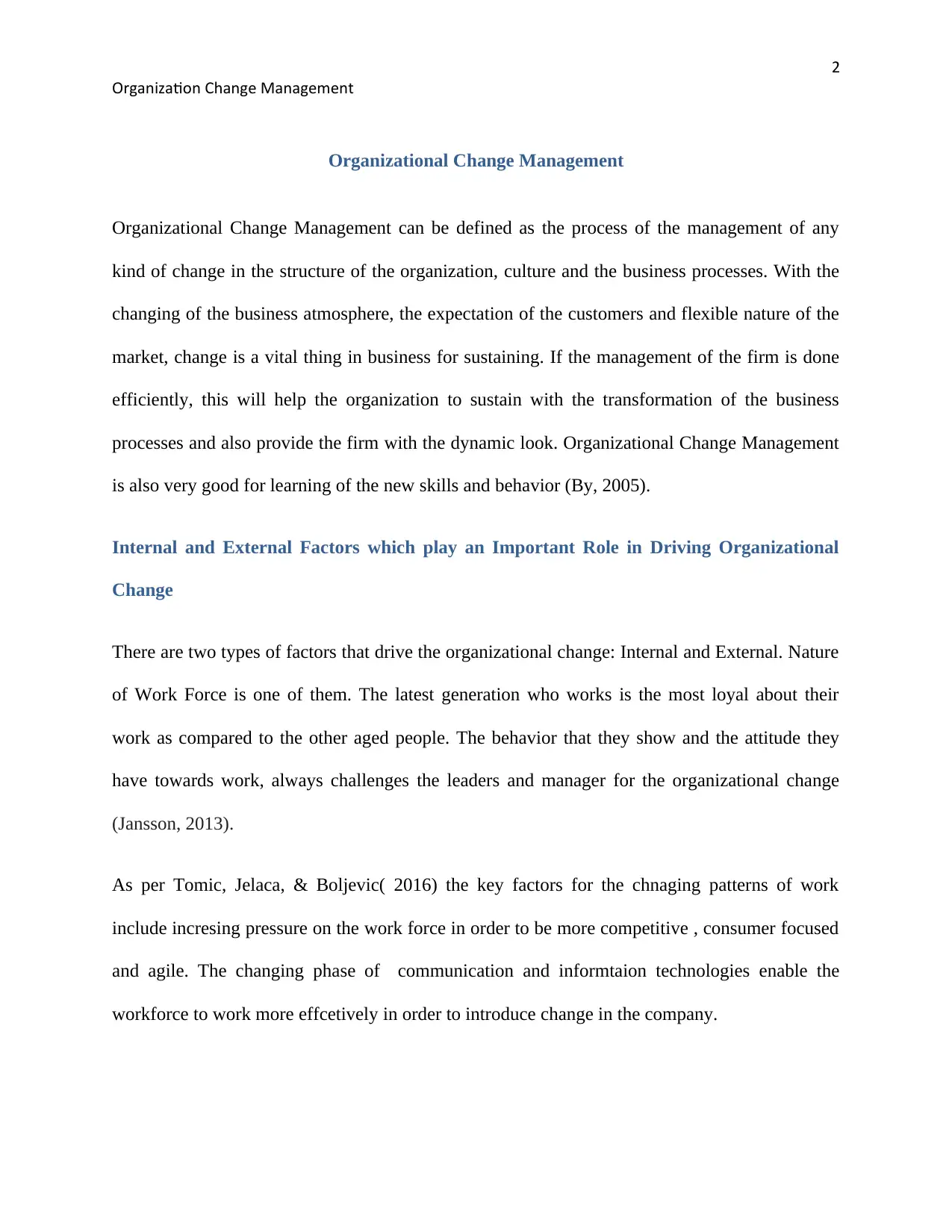
2
Organization Change Management
Organizational Change Management
Organizational Change Management can be defined as the process of the management of any
kind of change in the structure of the organization, culture and the business processes. With the
changing of the business atmosphere, the expectation of the customers and flexible nature of the
market, change is a vital thing in business for sustaining. If the management of the firm is done
efficiently, this will help the organization to sustain with the transformation of the business
processes and also provide the firm with the dynamic look. Organizational Change Management
is also very good for learning of the new skills and behavior (By, 2005).
Internal and External Factors which play an Important Role in Driving Organizational
Change
There are two types of factors that drive the organizational change: Internal and External. Nature
of Work Force is one of them. The latest generation who works is the most loyal about their
work as compared to the other aged people. The behavior that they show and the attitude they
have towards work, always challenges the leaders and manager for the organizational change
(Jansson, 2013).
As per Tomic, Jelaca, & Boljevic( 2016) the key factors for the chnaging patterns of work
include incresing pressure on the work force in order to be more competitive , consumer focused
and agile. The changing phase of communication and informtaion technologies enable the
workforce to work more effcetively in order to introduce change in the company.
Organization Change Management
Organizational Change Management
Organizational Change Management can be defined as the process of the management of any
kind of change in the structure of the organization, culture and the business processes. With the
changing of the business atmosphere, the expectation of the customers and flexible nature of the
market, change is a vital thing in business for sustaining. If the management of the firm is done
efficiently, this will help the organization to sustain with the transformation of the business
processes and also provide the firm with the dynamic look. Organizational Change Management
is also very good for learning of the new skills and behavior (By, 2005).
Internal and External Factors which play an Important Role in Driving Organizational
Change
There are two types of factors that drive the organizational change: Internal and External. Nature
of Work Force is one of them. The latest generation who works is the most loyal about their
work as compared to the other aged people. The behavior that they show and the attitude they
have towards work, always challenges the leaders and manager for the organizational change
(Jansson, 2013).
As per Tomic, Jelaca, & Boljevic( 2016) the key factors for the chnaging patterns of work
include incresing pressure on the work force in order to be more competitive , consumer focused
and agile. The changing phase of communication and informtaion technologies enable the
workforce to work more effcetively in order to introduce change in the company.
⊘ This is a preview!⊘
Do you want full access?
Subscribe today to unlock all pages.

Trusted by 1+ million students worldwide
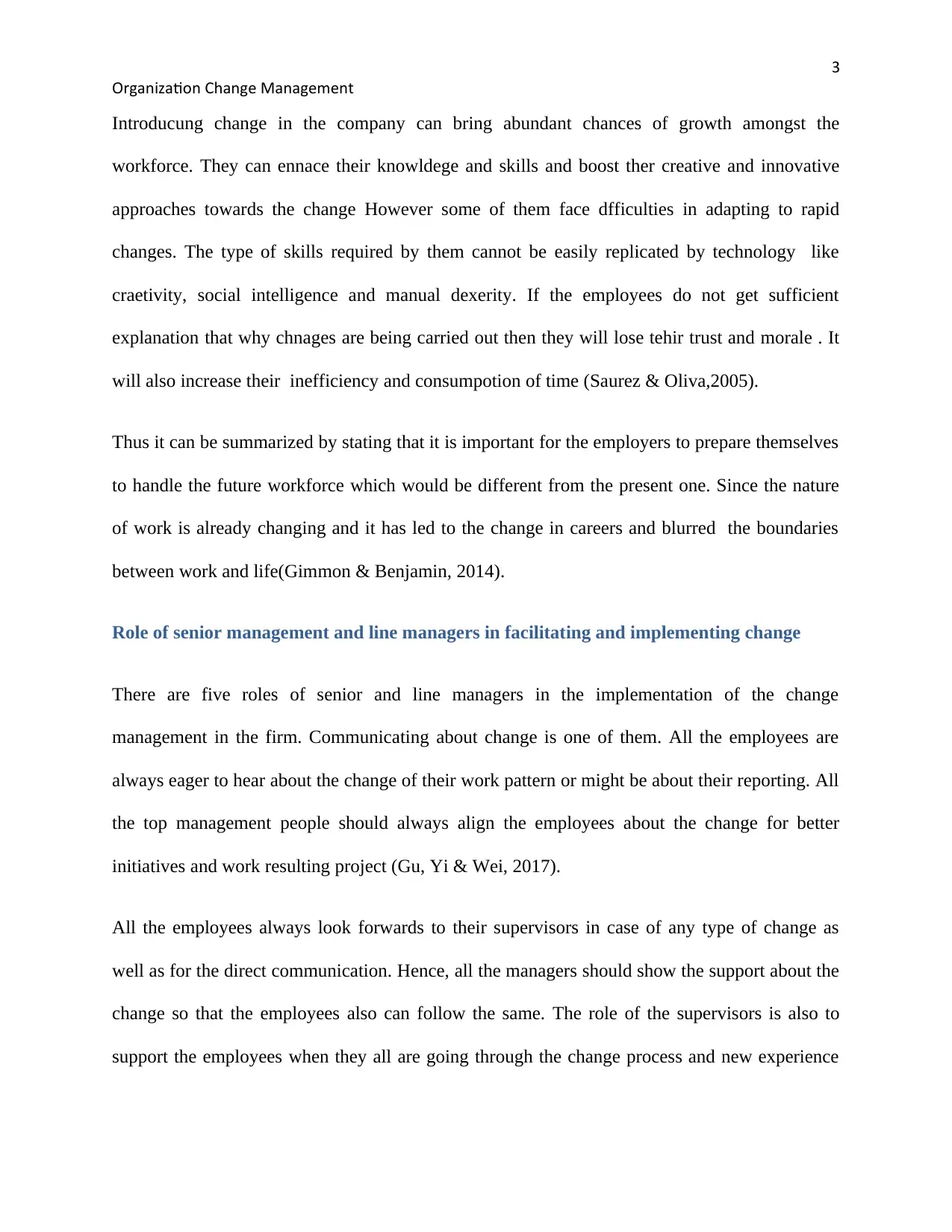
3
Organization Change Management
Introducung change in the company can bring abundant chances of growth amongst the
workforce. They can ennace their knowldege and skills and boost ther creative and innovative
approaches towards the change However some of them face dfficulties in adapting to rapid
changes. The type of skills required by them cannot be easily replicated by technology like
craetivity, social intelligence and manual dexerity. If the employees do not get sufficient
explanation that why chnages are being carried out then they will lose tehir trust and morale . It
will also increase their inefficiency and consumpotion of time (Saurez & Oliva,2005).
Thus it can be summarized by stating that it is important for the employers to prepare themselves
to handle the future workforce which would be different from the present one. Since the nature
of work is already changing and it has led to the change in careers and blurred the boundaries
between work and life(Gimmon & Benjamin, 2014).
Role of senior management and line managers in facilitating and implementing change
There are five roles of senior and line managers in the implementation of the change
management in the firm. Communicating about change is one of them. All the employees are
always eager to hear about the change of their work pattern or might be about their reporting. All
the top management people should always align the employees about the change for better
initiatives and work resulting project (Gu, Yi & Wei, 2017).
All the employees always look forwards to their supervisors in case of any type of change as
well as for the direct communication. Hence, all the managers should show the support about the
change so that the employees also can follow the same. The role of the supervisors is also to
support the employees when they all are going through the change process and new experience
Organization Change Management
Introducung change in the company can bring abundant chances of growth amongst the
workforce. They can ennace their knowldege and skills and boost ther creative and innovative
approaches towards the change However some of them face dfficulties in adapting to rapid
changes. The type of skills required by them cannot be easily replicated by technology like
craetivity, social intelligence and manual dexerity. If the employees do not get sufficient
explanation that why chnages are being carried out then they will lose tehir trust and morale . It
will also increase their inefficiency and consumpotion of time (Saurez & Oliva,2005).
Thus it can be summarized by stating that it is important for the employers to prepare themselves
to handle the future workforce which would be different from the present one. Since the nature
of work is already changing and it has led to the change in careers and blurred the boundaries
between work and life(Gimmon & Benjamin, 2014).
Role of senior management and line managers in facilitating and implementing change
There are five roles of senior and line managers in the implementation of the change
management in the firm. Communicating about change is one of them. All the employees are
always eager to hear about the change of their work pattern or might be about their reporting. All
the top management people should always align the employees about the change for better
initiatives and work resulting project (Gu, Yi & Wei, 2017).
All the employees always look forwards to their supervisors in case of any type of change as
well as for the direct communication. Hence, all the managers should show the support about the
change so that the employees also can follow the same. The role of the supervisors is also to
support the employees when they all are going through the change process and new experience
Paraphrase This Document
Need a fresh take? Get an instant paraphrase of this document with our AI Paraphraser
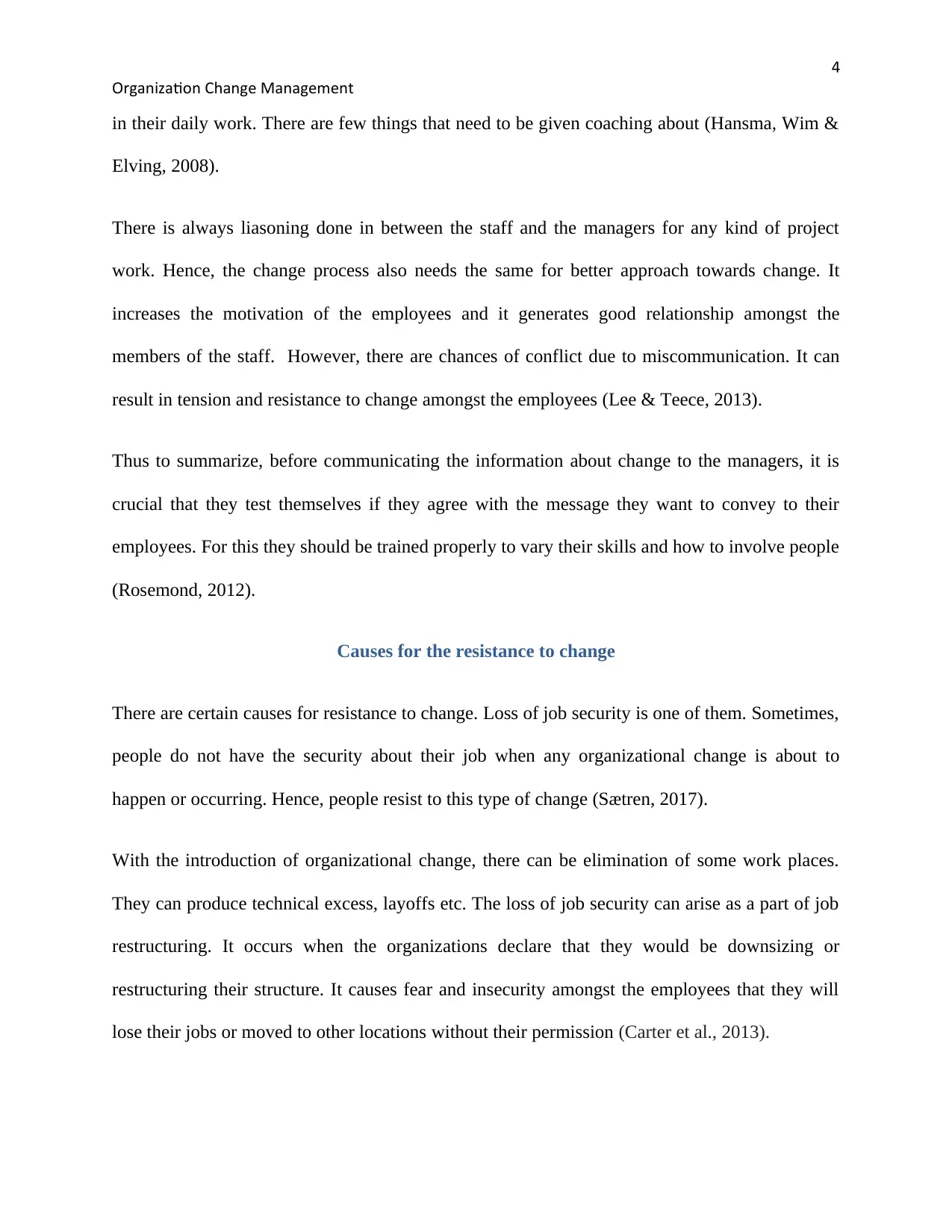
4
Organization Change Management
in their daily work. There are few things that need to be given coaching about (Hansma, Wim &
Elving, 2008).
There is always liasoning done in between the staff and the managers for any kind of project
work. Hence, the change process also needs the same for better approach towards change. It
increases the motivation of the employees and it generates good relationship amongst the
members of the staff. However, there are chances of conflict due to miscommunication. It can
result in tension and resistance to change amongst the employees (Lee & Teece, 2013).
Thus to summarize, before communicating the information about change to the managers, it is
crucial that they test themselves if they agree with the message they want to convey to their
employees. For this they should be trained properly to vary their skills and how to involve people
(Rosemond, 2012).
Causes for the resistance to change
There are certain causes for resistance to change. Loss of job security is one of them. Sometimes,
people do not have the security about their job when any organizational change is about to
happen or occurring. Hence, people resist to this type of change (Sætren, 2017).
With the introduction of organizational change, there can be elimination of some work places.
They can produce technical excess, layoffs etc. The loss of job security can arise as a part of job
restructuring. It occurs when the organizations declare that they would be downsizing or
restructuring their structure. It causes fear and insecurity amongst the employees that they will
lose their jobs or moved to other locations without their permission (Carter et al., 2013).
Organization Change Management
in their daily work. There are few things that need to be given coaching about (Hansma, Wim &
Elving, 2008).
There is always liasoning done in between the staff and the managers for any kind of project
work. Hence, the change process also needs the same for better approach towards change. It
increases the motivation of the employees and it generates good relationship amongst the
members of the staff. However, there are chances of conflict due to miscommunication. It can
result in tension and resistance to change amongst the employees (Lee & Teece, 2013).
Thus to summarize, before communicating the information about change to the managers, it is
crucial that they test themselves if they agree with the message they want to convey to their
employees. For this they should be trained properly to vary their skills and how to involve people
(Rosemond, 2012).
Causes for the resistance to change
There are certain causes for resistance to change. Loss of job security is one of them. Sometimes,
people do not have the security about their job when any organizational change is about to
happen or occurring. Hence, people resist to this type of change (Sætren, 2017).
With the introduction of organizational change, there can be elimination of some work places.
They can produce technical excess, layoffs etc. The loss of job security can arise as a part of job
restructuring. It occurs when the organizations declare that they would be downsizing or
restructuring their structure. It causes fear and insecurity amongst the employees that they will
lose their jobs or moved to other locations without their permission (Carter et al., 2013).
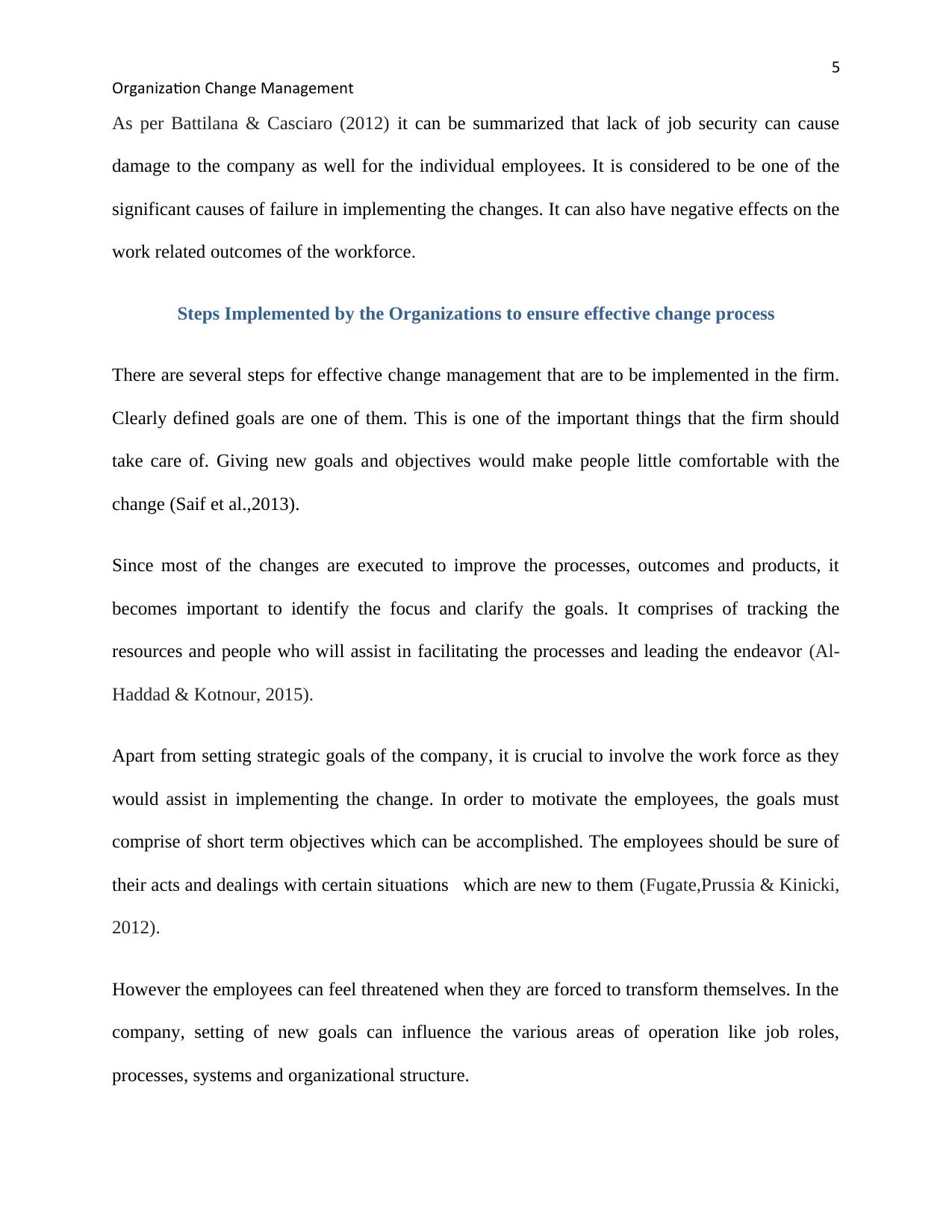
5
Organization Change Management
As per Battilana & Casciaro (2012) it can be summarized that lack of job security can cause
damage to the company as well for the individual employees. It is considered to be one of the
significant causes of failure in implementing the changes. It can also have negative effects on the
work related outcomes of the workforce.
Steps Implemented by the Organizations to ensure effective change process
There are several steps for effective change management that are to be implemented in the firm.
Clearly defined goals are one of them. This is one of the important things that the firm should
take care of. Giving new goals and objectives would make people little comfortable with the
change (Saif et al.,2013).
Since most of the changes are executed to improve the processes, outcomes and products, it
becomes important to identify the focus and clarify the goals. It comprises of tracking the
resources and people who will assist in facilitating the processes and leading the endeavor (Al-
Haddad & Kotnour, 2015).
Apart from setting strategic goals of the company, it is crucial to involve the work force as they
would assist in implementing the change. In order to motivate the employees, the goals must
comprise of short term objectives which can be accomplished. The employees should be sure of
their acts and dealings with certain situations which are new to them (Fugate,Prussia & Kinicki,
2012).
However the employees can feel threatened when they are forced to transform themselves. In the
company, setting of new goals can influence the various areas of operation like job roles,
processes, systems and organizational structure.
Organization Change Management
As per Battilana & Casciaro (2012) it can be summarized that lack of job security can cause
damage to the company as well for the individual employees. It is considered to be one of the
significant causes of failure in implementing the changes. It can also have negative effects on the
work related outcomes of the workforce.
Steps Implemented by the Organizations to ensure effective change process
There are several steps for effective change management that are to be implemented in the firm.
Clearly defined goals are one of them. This is one of the important things that the firm should
take care of. Giving new goals and objectives would make people little comfortable with the
change (Saif et al.,2013).
Since most of the changes are executed to improve the processes, outcomes and products, it
becomes important to identify the focus and clarify the goals. It comprises of tracking the
resources and people who will assist in facilitating the processes and leading the endeavor (Al-
Haddad & Kotnour, 2015).
Apart from setting strategic goals of the company, it is crucial to involve the work force as they
would assist in implementing the change. In order to motivate the employees, the goals must
comprise of short term objectives which can be accomplished. The employees should be sure of
their acts and dealings with certain situations which are new to them (Fugate,Prussia & Kinicki,
2012).
However the employees can feel threatened when they are forced to transform themselves. In the
company, setting of new goals can influence the various areas of operation like job roles,
processes, systems and organizational structure.
⊘ This is a preview!⊘
Do you want full access?
Subscribe today to unlock all pages.

Trusted by 1+ million students worldwide

6
Organization Change Management
Thus it can be summarized as the problems confronted by the organization in setting new goals
in the context of introducing changes can be resolved by dealing with them in a different manner.
The ultimate goal should be to improve the overall performance by changing things so that it
remains more competitive, consumer centric and efficient (Rizescu & Tileaga, 2016).
Strategies Implemented By the Organizations to Ensure a Change Capable Culture
There are three major theories when it comes to planned change. Lewin Change Model is one of
them .Lewin model had three stages Unfreezing, Changing and Refreezing. It is a simple process
of understanding the change. It creates the perception in the minds pf the people that there is
actually a need of change in the firms and it works towards the behavior and new desire to want
the change. This is one of the widely-used models in many change model processes.
It has fewer steps to be followed and is simple and easy to understand. It is an organized model
which is executed through steps. So, it is known to be the most efficient model in the field of
change management (Schaffer, Sandau & Diedrick, 2013).
As per Hussain et al., (2018) in every step of Lewin’s change model, the role of leadership is
involved as change agent for behavioral communications in the various aspects of roles and
society .It involves sharing of knowledge in the team ad suggesting relevant ideas amongst the
various levels of management.
However some of the negative implications of this model are that they are neither complex nor
they truly explain the roadmaps to route the intense policies and negative reactions encountered
by the staff. The theory suggests that changes happen in a single direction which is not possible
Organization Change Management
Thus it can be summarized as the problems confronted by the organization in setting new goals
in the context of introducing changes can be resolved by dealing with them in a different manner.
The ultimate goal should be to improve the overall performance by changing things so that it
remains more competitive, consumer centric and efficient (Rizescu & Tileaga, 2016).
Strategies Implemented By the Organizations to Ensure a Change Capable Culture
There are three major theories when it comes to planned change. Lewin Change Model is one of
them .Lewin model had three stages Unfreezing, Changing and Refreezing. It is a simple process
of understanding the change. It creates the perception in the minds pf the people that there is
actually a need of change in the firms and it works towards the behavior and new desire to want
the change. This is one of the widely-used models in many change model processes.
It has fewer steps to be followed and is simple and easy to understand. It is an organized model
which is executed through steps. So, it is known to be the most efficient model in the field of
change management (Schaffer, Sandau & Diedrick, 2013).
As per Hussain et al., (2018) in every step of Lewin’s change model, the role of leadership is
involved as change agent for behavioral communications in the various aspects of roles and
society .It involves sharing of knowledge in the team ad suggesting relevant ideas amongst the
various levels of management.
However some of the negative implications of this model are that they are neither complex nor
they truly explain the roadmaps to route the intense policies and negative reactions encountered
by the staff. The theory suggests that changes happen in a single direction which is not possible
Paraphrase This Document
Need a fresh take? Get an instant paraphrase of this document with our AI Paraphraser
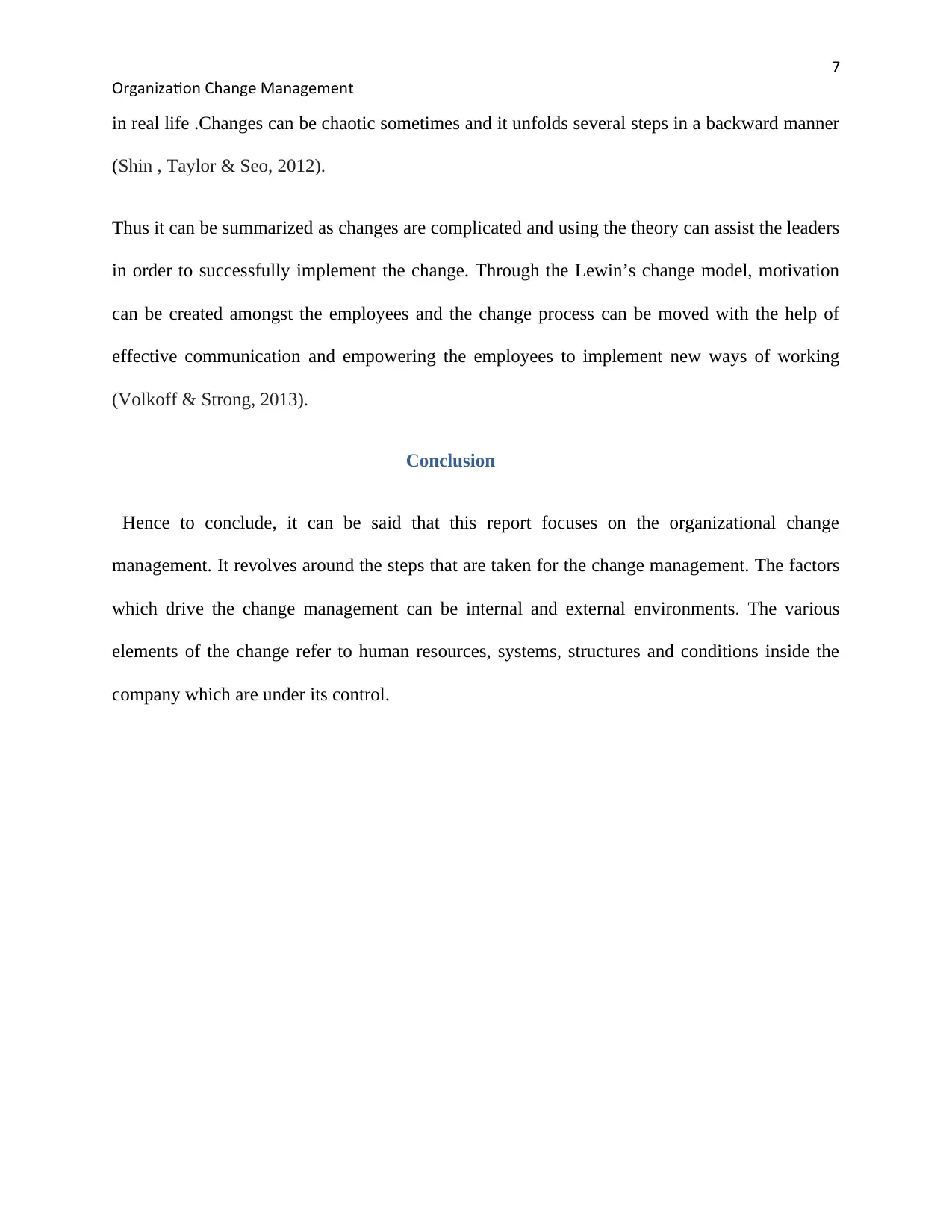
7
Organization Change Management
in real life .Changes can be chaotic sometimes and it unfolds several steps in a backward manner
(Shin , Taylor & Seo, 2012).
Thus it can be summarized as changes are complicated and using the theory can assist the leaders
in order to successfully implement the change. Through the Lewin’s change model, motivation
can be created amongst the employees and the change process can be moved with the help of
effective communication and empowering the employees to implement new ways of working
(Volkoff & Strong, 2013).
Conclusion
Hence to conclude, it can be said that this report focuses on the organizational change
management. It revolves around the steps that are taken for the change management. The factors
which drive the change management can be internal and external environments. The various
elements of the change refer to human resources, systems, structures and conditions inside the
company which are under its control.
Organization Change Management
in real life .Changes can be chaotic sometimes and it unfolds several steps in a backward manner
(Shin , Taylor & Seo, 2012).
Thus it can be summarized as changes are complicated and using the theory can assist the leaders
in order to successfully implement the change. Through the Lewin’s change model, motivation
can be created amongst the employees and the change process can be moved with the help of
effective communication and empowering the employees to implement new ways of working
(Volkoff & Strong, 2013).
Conclusion
Hence to conclude, it can be said that this report focuses on the organizational change
management. It revolves around the steps that are taken for the change management. The factors
which drive the change management can be internal and external environments. The various
elements of the change refer to human resources, systems, structures and conditions inside the
company which are under its control.
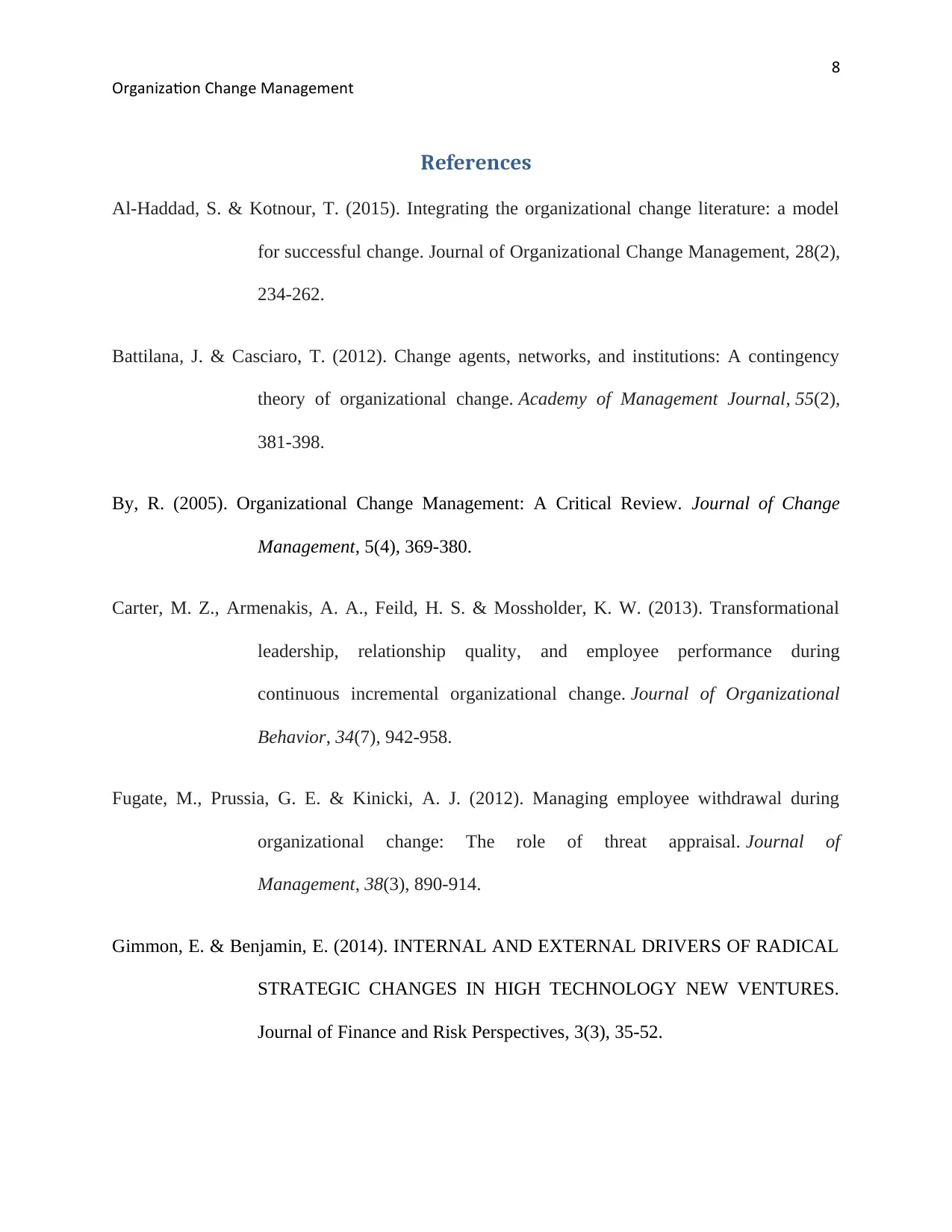
8
Organization Change Management
References
Al-Haddad, S. & Kotnour, T. (2015). Integrating the organizational change literature: a model
for successful change. Journal of Organizational Change Management, 28(2),
234-262.
Battilana, J. & Casciaro, T. (2012). Change agents, networks, and institutions: A contingency
theory of organizational change. Academy of Management Journal, 55(2),
381-398.
By, R. (2005). Organizational Change Management: A Critical Review. Journal of Change
Management, 5(4), 369-380.
Carter, M. Z., Armenakis, A. A., Feild, H. S. & Mossholder, K. W. (2013). Transformational
leadership, relationship quality, and employee performance during
continuous incremental organizational change. Journal of Organizational
Behavior, 34(7), 942-958.
Fugate, M., Prussia, G. E. & Kinicki, A. J. (2012). Managing employee withdrawal during
organizational change: The role of threat appraisal. Journal of
Management, 38(3), 890-914.
Gimmon, E. & Benjamin, E. (2014). INTERNAL AND EXTERNAL DRIVERS OF RADICAL
STRATEGIC CHANGES IN HIGH TECHNOLOGY NEW VENTURES.
Journal of Finance and Risk Perspectives, 3(3), 35-52.
Organization Change Management
References
Al-Haddad, S. & Kotnour, T. (2015). Integrating the organizational change literature: a model
for successful change. Journal of Organizational Change Management, 28(2),
234-262.
Battilana, J. & Casciaro, T. (2012). Change agents, networks, and institutions: A contingency
theory of organizational change. Academy of Management Journal, 55(2),
381-398.
By, R. (2005). Organizational Change Management: A Critical Review. Journal of Change
Management, 5(4), 369-380.
Carter, M. Z., Armenakis, A. A., Feild, H. S. & Mossholder, K. W. (2013). Transformational
leadership, relationship quality, and employee performance during
continuous incremental organizational change. Journal of Organizational
Behavior, 34(7), 942-958.
Fugate, M., Prussia, G. E. & Kinicki, A. J. (2012). Managing employee withdrawal during
organizational change: The role of threat appraisal. Journal of
Management, 38(3), 890-914.
Gimmon, E. & Benjamin, E. (2014). INTERNAL AND EXTERNAL DRIVERS OF RADICAL
STRATEGIC CHANGES IN HIGH TECHNOLOGY NEW VENTURES.
Journal of Finance and Risk Perspectives, 3(3), 35-52.
⊘ This is a preview!⊘
Do you want full access?
Subscribe today to unlock all pages.

Trusted by 1+ million students worldwide
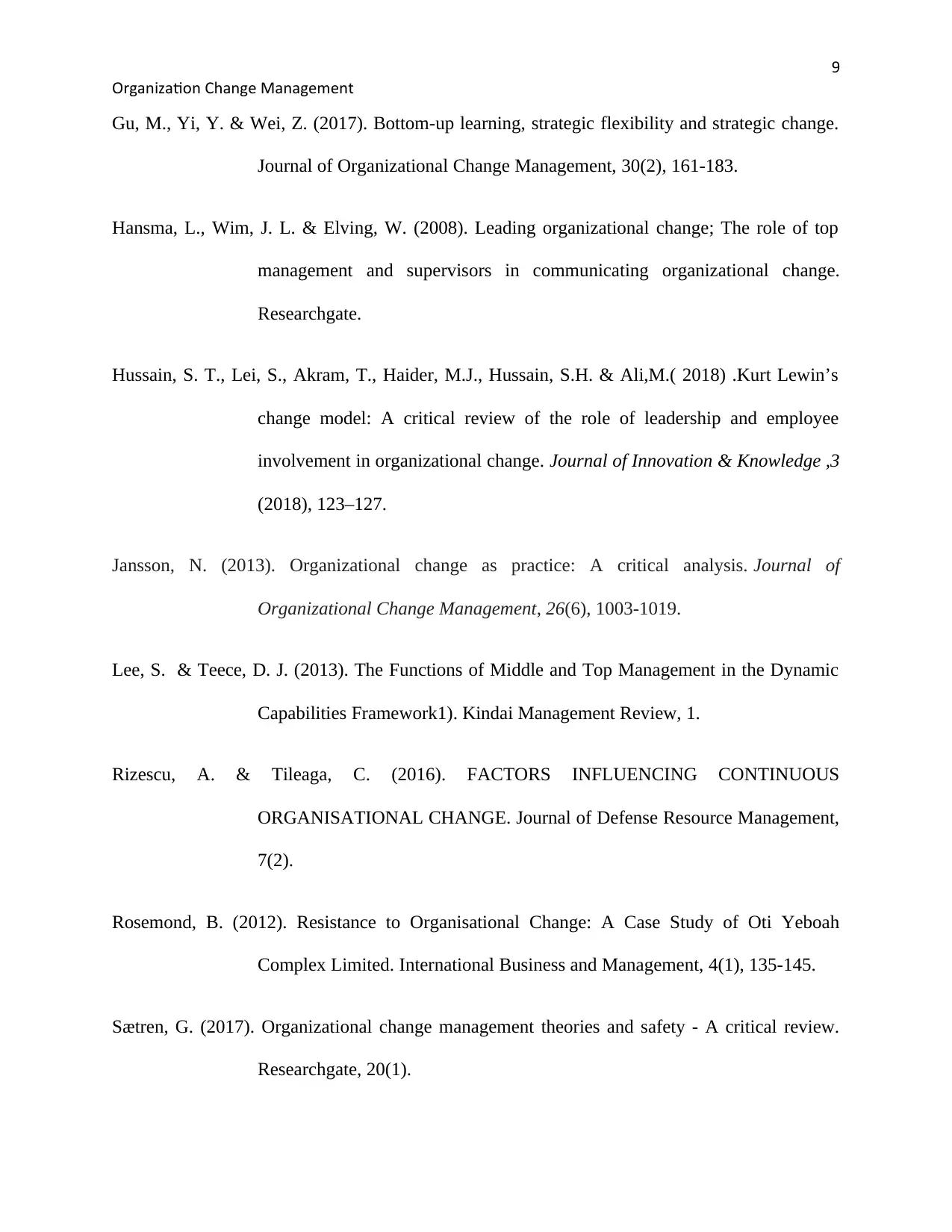
9
Organization Change Management
Gu, M., Yi, Y. & Wei, Z. (2017). Bottom-up learning, strategic flexibility and strategic change.
Journal of Organizational Change Management, 30(2), 161-183.
Hansma, L., Wim, J. L. & Elving, W. (2008). Leading organizational change; The role of top
management and supervisors in communicating organizational change.
Researchgate.
Hussain, S. T., Lei, S., Akram, T., Haider, M.J., Hussain, S.H. & Ali,M.( 2018) .Kurt Lewin’s
change model: A critical review of the role of leadership and employee
involvement in organizational change. Journal of Innovation & Knowledge ,3
(2018), 123–127.
Jansson, N. (2013). Organizational change as practice: A critical analysis. Journal of
Organizational Change Management, 26(6), 1003-1019.
Lee, S. & Teece, D. J. (2013). The Functions of Middle and Top Management in the Dynamic
Capabilities Framework1). Kindai Management Review, 1.
Rizescu, A. & Tileaga, C. (2016). FACTORS INFLUENCING CONTINUOUS
ORGANISATIONAL CHANGE. Journal of Defense Resource Management,
7(2).
Rosemond, B. (2012). Resistance to Organisational Change: A Case Study of Oti Yeboah
Complex Limited. International Business and Management, 4(1), 135-145.
Sætren, G. (2017). Organizational change management theories and safety - A critical review.
Researchgate, 20(1).
Organization Change Management
Gu, M., Yi, Y. & Wei, Z. (2017). Bottom-up learning, strategic flexibility and strategic change.
Journal of Organizational Change Management, 30(2), 161-183.
Hansma, L., Wim, J. L. & Elving, W. (2008). Leading organizational change; The role of top
management and supervisors in communicating organizational change.
Researchgate.
Hussain, S. T., Lei, S., Akram, T., Haider, M.J., Hussain, S.H. & Ali,M.( 2018) .Kurt Lewin’s
change model: A critical review of the role of leadership and employee
involvement in organizational change. Journal of Innovation & Knowledge ,3
(2018), 123–127.
Jansson, N. (2013). Organizational change as practice: A critical analysis. Journal of
Organizational Change Management, 26(6), 1003-1019.
Lee, S. & Teece, D. J. (2013). The Functions of Middle and Top Management in the Dynamic
Capabilities Framework1). Kindai Management Review, 1.
Rizescu, A. & Tileaga, C. (2016). FACTORS INFLUENCING CONTINUOUS
ORGANISATIONAL CHANGE. Journal of Defense Resource Management,
7(2).
Rosemond, B. (2012). Resistance to Organisational Change: A Case Study of Oti Yeboah
Complex Limited. International Business and Management, 4(1), 135-145.
Sætren, G. (2017). Organizational change management theories and safety - A critical review.
Researchgate, 20(1).
Paraphrase This Document
Need a fresh take? Get an instant paraphrase of this document with our AI Paraphraser

10
Organization Change Management
Saif, N., Razzaq, N., Rehman , S. U., Javed , A. & Ahmad , B. (2013). The Concept of Change
Management in Today’s Business World. Information and Knowledge
Management, 3(6).
Saurez, F. S. & Oliva, R. (2005). Environmental Change and Organizational Transformation.
Industrial and Corporate Change, 14(6), 1017-1041.
Schaffer, M. A., Sandau, K. E. & Diedrick, L. (2013). Evidence‐based practice models for
organizational change: overview and practical applications. Journal of
Advanced Nursing, 69(5), 1197-1209.
Shin, J., Taylor, M. S. & Seo, M. G. (2012). Resources for change: The relationships of
organizational inducements and psychological resilience to employees'
attitudes and behaviors toward organizational change. Academy of
Management journal, 55(3), 727-748.
Tomic, S., Jelaca, M. S. & Boljevic, A. (2016). Exploring the Contribution of a Changing
External and Internal Organizational Context to the Innovation of Large
Organizations. Acta Polytechnica Hungarica, 13(6).
Volkoff, O. & Strong, D. M. (2013). Critical Realism and Affordances: Theorizing IT-associated
Organizational Change Processes. Mis Quarterly, 37(3).
Organization Change Management
Saif, N., Razzaq, N., Rehman , S. U., Javed , A. & Ahmad , B. (2013). The Concept of Change
Management in Today’s Business World. Information and Knowledge
Management, 3(6).
Saurez, F. S. & Oliva, R. (2005). Environmental Change and Organizational Transformation.
Industrial and Corporate Change, 14(6), 1017-1041.
Schaffer, M. A., Sandau, K. E. & Diedrick, L. (2013). Evidence‐based practice models for
organizational change: overview and practical applications. Journal of
Advanced Nursing, 69(5), 1197-1209.
Shin, J., Taylor, M. S. & Seo, M. G. (2012). Resources for change: The relationships of
organizational inducements and psychological resilience to employees'
attitudes and behaviors toward organizational change. Academy of
Management journal, 55(3), 727-748.
Tomic, S., Jelaca, M. S. & Boljevic, A. (2016). Exploring the Contribution of a Changing
External and Internal Organizational Context to the Innovation of Large
Organizations. Acta Polytechnica Hungarica, 13(6).
Volkoff, O. & Strong, D. M. (2013). Critical Realism and Affordances: Theorizing IT-associated
Organizational Change Processes. Mis Quarterly, 37(3).
1 out of 11
Related Documents
Your All-in-One AI-Powered Toolkit for Academic Success.
+13062052269
info@desklib.com
Available 24*7 on WhatsApp / Email
![[object Object]](/_next/static/media/star-bottom.7253800d.svg)
Unlock your academic potential
Copyright © 2020–2025 A2Z Services. All Rights Reserved. Developed and managed by ZUCOL.





